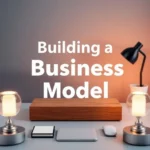Lean startup model: The path to effective customer validation
Understanding the nuances of customer validation for advanced practitioners

Beyond the basics: Why traditional validation methods fall short
Traditional validation methods often rely heavily on quantitative metrics, which can obscure the real insights needed for effective decision-making. These approaches tend to focus on metrics like downloads or clicks, neglecting the qualitative aspects that reveal true customer intent. As a startup, understanding the depth of user experience is crucial; thus, you should consider evolving your validation methods.
The Lean Startup Model emphasizes iterative learning through continuous feedback loops, creating a cyclical process rather than a linear one. By incorporating regular feedback from your customers, you can adapt swiftly to changes in their needs, which is essential for maintaining relevance in a fast-moving market. This cultural shift towards consistent learning fosters innovation and responsiveness.
It’s vital to prioritize validated learning over vanity metrics. While vanity metrics can provide a superficial sense of success, validated learning focuses on how well your product fulfills customer needs in real-world scenarios. By understanding this distinction, startups can navigate toward more meaningful growth trajectories.
Surveys have traditionally been a staple for gathering customer feedback, but they often fail to capture the nuanced experiences of users. Embracing qualitative data through interviews, focus groups, and user testing can uncover deeper insights into customer pain points, allowing you to craft targeted solutions. By implementing methods that invite customers to articulate their experiences, you gather authentic perspectives.
Advanced customer discovery techniques
Conducting problem interviews allows you to explore the core challenges your customers face. This technique goes beyond mere surface-level inquiries, digging deeper into their frustrations and needs. By understanding these pain points, you position yourself to offer solutions that genuinely resonate, improving both product-market fit and customer satisfaction.
Solution interviews offer the chance to test your assumptions directly with potential customers. During these interactions, you can present your ideas and gather feedback on their appeal and effectiveness. This proactive approach helps in validating your concepts and ensures that you are building something that aligns with user expectations.
Concierge testing enables you to deliver tailored solutions to a select group of customers while actively observing their interactions. This hands-on approach not only makes customers feel valued but also provides you with invaluable data to refine your offerings. This method can efficiently expose flaws and strengths in your services before launching at scale.
Building a minimum viable product (MVP) for advanced validation

Defining your MVP for a sophisticated audience
Creating a Minimum Viable Product (MVP) requires focus on core value propositions. Your MVP should embody the essence of your solution while appealing to early adopters who will provide crucial feedback. By narrowing down features to essentials, you reduce complexity and accelerate time-to-market, giving you a competitive edge.
Identify and emphasize the core value propositions you are offering. This clarity not only helps in feature selection but also communicates effectively to early adopters who can further validate your concept. Understanding your value in the context of customer pain points ensures more engaged and meaningful interactions.
When prioritizing features, consider the specific needs of early adopters who are willing to experiment with your MVP. Their feedback can be pivotal for refining the product, as these users are often more forgiving of shortcomings and appreciate innovation. Focusing on securing a loyal base can provide vital validation as you evolve.
Feature creep—the gradual expansion of product features without corresponding benefits—can dilute your MVP’s effectiveness. Maintaining laser focus on what truly matters ensures that your product remains simple and effective. This approach can prevent wasted resources and keeps your early adopters engaged without overwhelming them.
Testing and iterating your MVP with advanced users
A/B testing is an invaluable method for gathering nuanced user feedback. By presenting variations of your product to different user groups, you can identify which features resonate more effectively. This data-driven approach allows startups to make informed decisions about which elements to enhance or discard.
Cohort analysis is another critical tool for understanding user behavior over time. By examining user segments based on when they interacted with your product, you can identify trends and patterns. This deep level of analysis enhances your understanding of user retention and satisfaction, guiding your future iterations.
Incorporating user feedback tools streamlines the process of gathering and analyzing customer insights. Platforms that facilitate feedback collection can rapidly inform your development cycles. By actively engaging with your users, you show that their opinions matter, and this engagement can drive both loyalty and advocacy.
Metrics and measurement for advanced customer validation

Key performance indicators (KPIs) beyond basic engagement
Measuring success requires a robust set of KPIs that go beyond basic engagement metrics. By focusing on more sophisticated indicators, you can gain a deeper understanding of your customers and their interactions with your product. This holistic approach leads to better decision-making and strategic planning.
One significant metric is Customer Lifetime Value (CLTV), which gauges how much revenue a customer generates over the duration of their engagement. Understanding CLTV allows startups to determine how much they can invest in acquiring new customers while maintaining profitability. This insight becomes critical as you scale your business.
Tracking customer churn alongside retention rates provides valuable insights into your product’s effectiveness. High churn rates may indicate underlying issues that need to be addressed, while strong retention suggests satisfaction with your offering. Understanding these dynamics aids in refining your strategies to enhance customer loyalty.
Analyzing product usage data can surface actionable insights that inform product enhancements. By evaluating how customers interact with different features, you can prioritize development efforts. This data-driven approach not only refines your product but also enhances the overall user experience.
Data-driven decision making for continuous improvement
Effective product development hinges on data-driven decision-making. By leveraging analytics, you can understand user behavior and preferences, leading to well-informed adaptations to your product. This reliance on data fosters a responsive development cycle that prioritizes customer needs.
Continuous iteration based on customer feedback and analytical insights is key to staying relevant. As the market evolves, so should your product; regularly revisiting user suggestions can guide essential updates and improvements. By embedding feedback loops into your development process, you ensure that your offering remains competitive.
Cultivating a data-driven culture within your organization ensures that everyone is aligned towards a common goal—meticulous customer validation. Encouraging teams to rely on insights rather than assumptions creates a more dynamic approach to problem-solving. This cultural shift supports sustainable growth and minimizes risks associated with neglecting customer feedback.
Scaling customer validation for growth

Maintaining validation rigor as your customer base expands
As your user base grows, maintaining validation rigor becomes increasingly important. Large-scale feedback mechanisms can replace one-on-one interactions, but they must be managed carefully to avoid dilution of insights. A structured approach to scaling these efforts is necessary to ensure ongoing refinement of your product and responsiveness to user needs.
Establishing scalable customer feedback loops ensures that you continue gathering valuable insights without overwhelming resources. Utilizing surveys, interviews, and performance metrics systematically will maintain quality in feedback collection. Being intentional about these processes helps sustain engagement and input from a larger audience.
Embracing automation in data collection enhances efficiency and allows for real-time insights. Automated tools can streamline survey distribution and analysis, freeing valuable time for deeper analytical tasks. This operational efficiency becomes crucial as your customer base expands, ensuring that data collection keeps pace with growth.
Segmenting your audience enables more targeted validation efforts, as different groups may have unique needs and challenges. This approach ensures that you are collecting relevant insights tailored to specific demographics, improving the precision of your feedback. By aligning your validation efforts with user segments, you can refine offerings more effectively.
Advanced strategies for long-term customer engagement
Achieving long-term customer engagement necessitates advanced strategies that go beyond basic retention efforts. Building a sense of community around your product fosters loyalty and advocacy, creating a network that can bolster your brand’s reputation. By investing in relationships with your customers, you not only enhance their experience but also gather ongoing insights for improvement.
Community building involves creating spaces—online or offline—where customers can connect, share experiences, and provide feedback. Such environments not only enhance user engagement but also provide rich qualitative data that traditional methods may miss. By nurturing these connections, you foster loyalty and facilitate an organic feedback loop.
A customer advisory board can act as a sounding board for your product’s direction and decisions. Inviting select customers to share their insights fosters a collaborative environment and signals to your audience that their opinions are valued. This strategy not only enriches your product vision but builds trust and enhances engagement.
Incorporating customer feedback directly into your product roadmap planning ensures that your development aligns with user needs. When customers see their suggestions reflected in product updates, it fosters a sense of ownership and investment in your brand. This alignment not only strengthens relationships but also drives sustainable growth through informed decisions.












